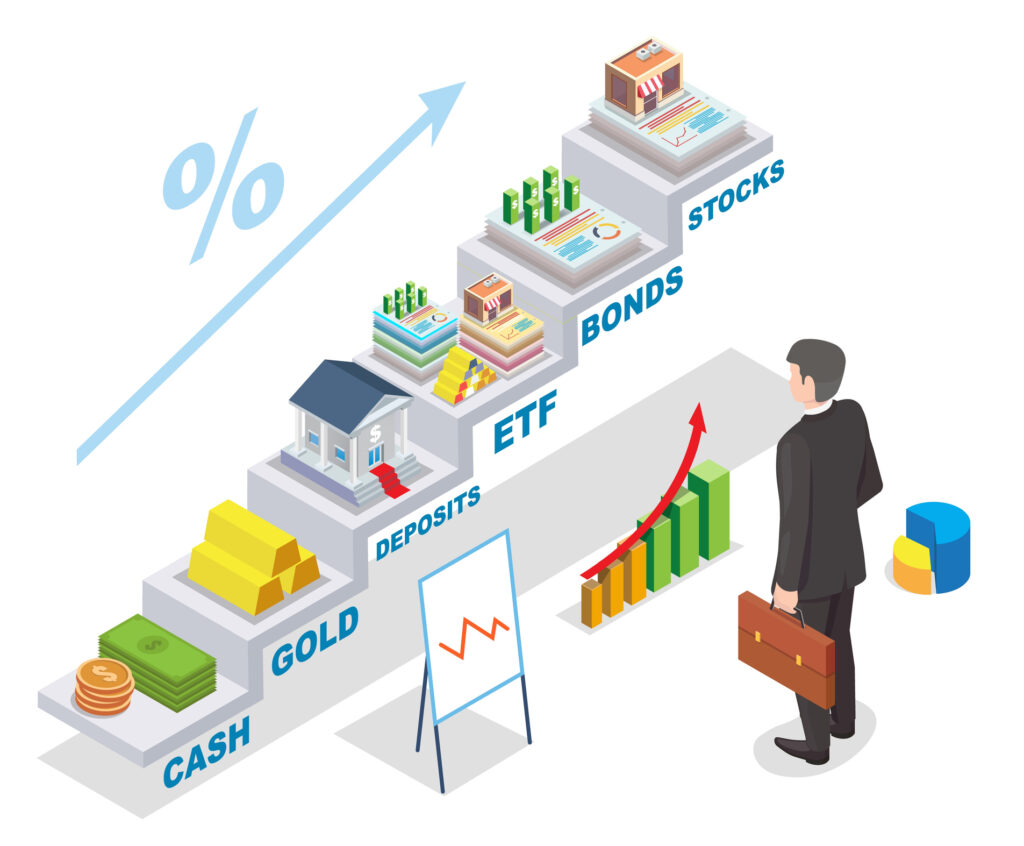Introduction
Do low-risk investments achieve the goal of delivering growth without undue risk in the post-pandemic, cost-of-living crisis, war-stricken world that 2023 has given us?
With the current high levels of inflation, do we need to take more risk to stay in the game, or are we still content with our traditional bonds and fixed-term deposits?
There are other options that we can uncover in this comprehensive guide to “low-risk investments” in 2023!
Let’s jump in and see what we find…
Understanding Risk: Low-risk investments, strategies for growth
When it comes to investments, risk is inevitable.
But what if you had inside knowledge of the investment world, where the risks are minimal and the returns are attractive?
Your primary goal might be capital preservation, but it doesn’t mean you should forgo looking for good returns.
Furthermore, what is “risk”? Most people think of volatility as “risk”. Without volatility, it’s almost impossible to achieve growth.
What factors to consider when choosing a low-risk investments
For those who lean toward risk-averse investing, the key lies in conservative investment techniques.
This involves diversification across sectors, choosing long-term low-risk investments, and often people wrongly turn to low-volatility investments.

Should I be Investing in the Stock Market?
Stock Market investing can be very lucrative, and there are many defensive, safe stocks available to choose from.
Ultimately, everyone should be invested in the stock market to some level because, over the medium to long term, you will make money if your investment is well diversified.
The stock market is a complicated place for amateur investors, and many people have fallen foul of simple mistakes and emotional decisions over the years.
Many trusted investment platforms can offer insights, analytics, and comparisons to help you make informed decisions when choosing stocks.
But where do we even start, considering there are over 65,000 stocks and shares in the world, we are in a “needle in a hey-stack world”.
But, there are great stocks out there, in established companies, that deliver good returns and dividends without the need for you to take unnecessary risks.
If you want to learn how to access them, then keep reading…….

Best low-risk investments 2023
Let’s break this down to its simplest form. There are only two ways to invest:
- Lump Sum Investment – Investing in an asset or group of assets with a chunk of money invested at the outset.
- Regular savings – Investing your salary on a monthly/quarterly/half/Yearly basis
That is it, there are no other ways!

Low-risk Lump Sum Investment options
With this strategy you can either:
A – Buy single low-risk assets such as Bonds, Dividend-paying stocks, Real Estate Investment Trusts (REITs) & ETFs and hold them individually.
B – Open up a low-cost Investment Platform/Brokerage Account/Personalised Portfolio Bond (PPB) where you can buy all of the above, hold them in an investment wrapper, and manage all of your investments from one centralised account.
In my opinion, without a doubt, option B is by far the better choice.
When you initiate an investment account, it’s like stepping into a realm of diverse investment possibilities. These accounts provide a unified platform to oversee all your assets. They come with advantages like streamlined management, affordable entry-level pricing, growth without the burden of taxes, relief from inheritance taxes, and numerous other benefits.
Low-Risk Regular Savings Options
Your options are a little broader if you want to invest regularly. You can read our guide here.
You can choose the Lump Sum option and then drop money in every quarter or whenever it is convenient for you to do so if you are a dedicated saver. If you are disciplined, then this is a good option, but often we find that flexibility allows the investor too much freedom and investment goals become harder to achieve.
For those people who need structure and commitment, then an account which automatically extracts money from your bank might be the safer option for you.
With this approach, an agreed, predetermined amount is automatically deducted from your account every month and invested on your behalf.
Typically expatriates often turn to specialized financial institutions for their savings needs. Companies such as Generali, Zurich, Skandia, Royal London (RL 360) and Friends Provident.
However, it’s essential to understand their offerings in depth.
These accounts can deliver very good returns for individuals if they are administered and managed under the correct terms and conditions, but if not then they may not deliver the fruitful growth that was promised at the point of signing.
Your financial journey is personal, and it’s crucial to choose the right option from the outset.
While the flexibility of the lump sum approach might allure some, others might find more success in the structure of automated savings.
Understanding your expat investment account is critical before diving in.
Remember, an informed decision today can be the difference between financial freedom & financial frustration tomorrow.

Option 1. Investment Platform/Brokerage Account/Personalised Portfolio Bond (PPB)
These accounts are the smart investor’s best friend.
You are able to invest in a limitless range of investments from ultra-low-risk investments like US Treasury Bonds (T-Bills) which are currently paying investors around 4% a year (inflation at the time of writing was 3.67%) all the way up to ultra-high-risk Cryptocurrency ETFs, which can swing in price by hundreds of percent overnight.
I would advise avoiding both of these and look more towards tracking an index. A global, countrywide & business sector index, or a combination of all three is good advice.
Look at purchasing somewhere in the region of 5-10 different index-tracking funds or ETFs. With this amount of funds, and invested correctly, you should have good asset allocation and a well-diversified portfolio.
This sturdy and resilient approach is an excellent way to enter the low-risk investments sector with a broad range of funds that can provide ample growth to make your investment endeavour safe and secure whilst also yielding good returns.
Start by thinking macro/big and aim your money towards long-established indexes like the MSCI World as your option for a global index. The Morgan Stanley Consumer Index (MSCI World) “tracks the performance of large and mid-cap companies across 23 developed countries”.
For a country-wide index you could invest in the Dow Jones Industrial Average or the S&P 500.
By placing your money into the S&P 500, you are entering an index with a history of averaging returns of over 10% annually since its debut.
As an investor, you’ll be aligning your fortunes with giants like Amazon, Microsoft, and Apple, all of which stand tall in the S&P 500 portfolio.
Business sector, I would suggest something safe like Consumer Staples or Health Care. Typically these are regarded as stable and low-risk investments and should take care of your low-risk portfolio needs.
All of these index funds and ETFs can be accessed through platforms such as:
- Access Portfolio – Low fees for the med-long term investor
Please feel free to contact us for some free tips and advice on how to access these investments.

Option 2. Regular Savings Options: Low-Risk Investments
Regular investing, particularly over the span of 15 years, has been shown to yield significant returns.
If you are targeting a sturdy foundation for your funds, look no further than an account linked with the S&P 500 Index.
This model seamlessly blends the advantage of the S&P 500’s renowned performance with the assurance of a capital-guaranteed scheme.
When we talk about guaranteed returns, the figures speak for themselves. Initiate your investment journey with a 100% guaranteed return over a 10-year horizon. For the medium-haul investors aiming for a 15-year term, a robust 140% return awaits. (This is a minimum guarantee and investors can realistically expect returns of 8%)
The S&P 500 isn’t just an index—it’s a testament to the strength of the US stock market.
Every investment avenue comes with its own set of risks. However, with a solid 19-year legacy and a flawless record of timely payouts, this investment plan has passed the test of time.
Behind the Scenes: The Trustworthy Institution
Entrusting your capital to the right institution is paramount. Enter Investors Trust—a globally recognized investment titan with an expansive reach across multiple domains and borders.
Their reputation as a reliable tried and tested facilitator in the investment arena has been further cemented by their affiliation with this top-tier investment plan.
To delve deeper into their expertise, there’s a wealth of information awaiting you.
In the world of investments, navigating the markets requires both knowledge and trust. With the S&P 500’s guaranteed return on investment account, you’re not just investing; you are fortifying your financial future.
Strategies for Long-term low-risk investments
The art of investing is not just about immediate gains. It’s about playing the long game, especially when eyeing low-risk investments that deliver healthy returns.
Secure your financial future by thinking ahead, way ahead! Short-term gains are high risk and this is not what we are trying to achieve here
Mastering Low-risk investment strategies
Expats need a tailored approach, one size doesn’t fit all.
By mastering specific low-risk investments, you’re setting up for not just good but great returns without the sleepless nights, worrying about your capital.
Diving into low-risk stocks to invest in
2023 is shaping up to be a promising year. With robust market insights, zeroing in on low-risk stocks to invest in becomes less of a gamble and more of a strategic move.
Structure. Stability. Strategy. These are the cornerstones of secure financial plans. Whether you’re a newbie an amateur or a seasoned investor, a well-crafted financial plan is your key to success.
Decoding Stable investment options
Market turbulence? Economic downturns? Bypass these worries by opting for stable investment options. A capital guarantee is the proverbial golden ticket in the world of low-risk investments.
Like a ship’s anchor, they keep you grounded during financial storms.
Insight into Risk-averse investing
Some investors love the thrill of risks, and then there are those who prefer the calmness of risk-averse investing. If you’re in the latter group, the conservative approach is your best ally.
Navigating Trusted investment platforms
In today’s digital age, investing is just a click away. But where should you click? Expats, more than anyone, need trusted investment platforms that cater to their unique needs.
There are many options out there but always read the small print. If you are an amateur then you may need the help of a professional, but choosing the right advisor and company is critical for the future of your investment.
Please read our detailed guide on how to choose the right advisor.
Conclusion
Whether you are a regular, young, old or wealthy expat, you have a world of investment opportunities waiting for you.
By focusing on low-risk avenues, not only do you safeguard your wealth, but you also ensure your money grows consistently.
It’s not just about playing safe; it’s about playing smart!

FAQs
- What are the best low-risk investments for retirees?
- Retirees often gravitate towards bonds, fixed deposits, and certain mutual funds due to their stability and reliable returns.
- How can beginners choose low-risk investments?
- Beginners can start with mutual funds, especially index funds, or consult with financial advisors to guide them through their initial investment journey.
- What are the top recommended low-risk investment books?
- “The Little Book of Common Sense Investing” by John C. Bogle and “The Intelligent Investor” by Benjamin Graham are excellent starters.
- How much return can you expect from low-risk investments?
- Typically, low-risk investments yield returns in the range of 2% to 6%, but this can vary based on economic factors and specific investment vehicles.
- Are there any apps for tracking low-risk investments?
- Absolutely! Apps like Mint, Personal Capital, and YNAB allow tracking of various investments, including low-risk ones.
- How do low-risk investments compare to high-risk ones?
- Low-risk investments offer steadier, predictable returns with less potential for massive gains or losses compared to high-risk options.
- What factors to consider before choosing a low-risk investment?
- Consider factors like investment duration, expected returns, liquidity needs, and market conditions.
- Are mutual funds considered low-risk investments?
- Some mutual funds, like index funds or bond funds, are considered low-risk, while others can be more volatile.
- How often should I review my low-risk investment portfolio?
- Ideally, a semi-annual or annual review is good, but always stay updated with market news and adjust accordingly.
- Can low-risk investments beat inflation?
- While some low-risk investments might offer returns slightly above inflation, diversifying your portfolio is key to effectively combat inflation.



